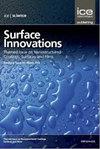沉积参数对射频溅射WO3薄膜的影响
IF 3.5
4区 材料科学
Q3 CHEMISTRY, PHYSICAL
引用次数: 3
摘要
在无氧条件下,采用射频磁控溅射技术在ITO导电玻璃衬底上制备了氧化钨(WO3)薄膜。系统地研究了溅射功率、工作气压、衬底偏置电压和衬底温度对薄膜表面形貌、微观结构、光学性能和电致变色性能的影响。研究表明,在80 ~ 100 W的溅射功率下,沉积速率为~ 10 ~ 2 nm/s,有利于获得非致密薄膜。同样,1.0 Pa的工作气压也会导致松散薄膜的沉积,有利于WO3薄膜的透光率和EC性能的提高。施加的衬底偏压对WO3薄膜的光学性能影响不大,但会降低WO3薄膜的着色和/或漂白效率,并大大降低其光学调制能力。当衬底温度上升到600℃时,薄膜开始结晶并呈现棒状多孔结构,导致光调制量小幅增加。本文章由计算机程序翻译,如有差异,请以英文原文为准。
Effects of deposition parameters on RF-sputtered WO3 thin films
In the absence of additional oxygen, thin films of tungsten oxide (WO3) were prepared on ITO conductive glass substrates by radio-frequency (RF) magnetron sputtering. The effects of sputtering power, working air pressure, substrate bias voltage and substrate temperature on the surface morphology, microstructure, optical properties and electrochromic (EC) performance of the films were systematically investigated. The research shows that the sputtering power of 80-100 W can ensure a moderate deposition rate of ∼10−2 nm/s and help to obtain nondense films. Similarly, the working air pressure of 1.0 Pa also leads to the deposition of loose films, which benifits for the improving of optical transmittance and EC performance of WO3 thin films. The applied substrate bias has little effect on the optical properties, but it will degrade the coloring and/or bleaching efficiency of WO3 thin films and greatly reduce their optical modulation. When the substrate temperature rises to 600 °C, the film begins to crystallize and exhibits a rods-patterned porous structure, which leads to a small increase in the optical modulation.
求助全文
通过发布文献求助,成功后即可免费获取论文全文。
去求助
来源期刊

Surface Innovations
CHEMISTRY, PHYSICALMATERIALS SCIENCE, COAT-MATERIALS SCIENCE, COATINGS & FILMS
CiteScore
5.80
自引率
22.90%
发文量
66
期刊介绍:
The material innovations on surfaces, combined with understanding and manipulation of physics and chemistry of functional surfaces and coatings, have exploded in the past decade at an incredibly rapid pace.
Superhydrophobicity, superhydrophlicity, self-cleaning, self-healing, anti-fouling, anti-bacterial, etc., have become important fundamental topics of surface science research community driven by curiosity of physics, chemistry, and biology of interaction phenomenon at surfaces and their enormous potential in practical applications. Materials having controlled-functionality surfaces and coatings are important to the manufacturing of new products for environmental control, liquid manipulation, nanotechnological advances, biomedical engineering, pharmacy, biotechnology, and many others, and are part of the most promising technological innovations of the twenty-first century.
 求助内容:
求助内容: 应助结果提醒方式:
应助结果提醒方式:


